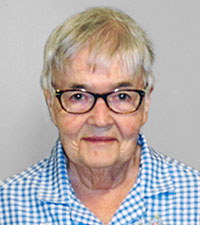 Sister Joan knew she wanted to be a sister when she was in fourth grade. A young Dominican sister was her teacher at that time. Sister Joan admired her and thought she would like to be like her.
Sister Joan knew she wanted to be a sister when she was in fourth grade. A young Dominican sister was her teacher at that time. Sister Joan admired her and thought she would like to be like her.
She remembers asking her aunt, “How do you become a sister?” Her aunt answered her question in this way: “If the Lord wants you to be a sister, he will show you the way.” Joan entered the convent after eighth grade. That was in 1949.
Sister Joan remembers her summers as an Aspirant in Aurora, Illinois. Those were happy days! She remembers going to St. Michael’s Church on Sundays and experiencing the Eastern Catholic Rite. Also she remembers an outing to a nearby farm for a picnic. The farm family had just gotten a TV She had always loved movies, so she spent most of her afternoon watching the TV.
Her first years of teaching were at Forest Park, Illinois. She had 60 first graders. She remembers one of the sisters, who was to help mentor her, told her to go to school and bring her manuals back to the house and she would help Joan with her lesson plans. Sister Joan obediently went to school to her classroom, but couldn’t find any manuals. She didn’t know what a manual was. Finally the sister who had sent her to get the manuals appeared and “saved the day”.
Sister Joan had always wanted to be a missionary, so when the community asked for sisters who might want to go to Costa Rica, Sister Joan volunteered. She didn’t realize they were looking for teachers to staff St. Claire College, which was equivalent to our high schools. Sister Joan taught English to the boys, and accompanied Sister Carol Jean Ory to one of the poor barrios, where they worked with the people.
One of the challenges Sister Joan experienced was going to the market for the first time. “It was a real culture shock! I remember walking into the market, and right there hung a butchered cow. The meat was cut right off the cow, wrapped in paper and given to the customer.” As they walked through the market, the smell was getting to her. Thank goodness there were doors every now and then, so she could step outside to get some fresh air. “I think I might have gone out every door,” she recalled.
Her missionary days didn’t end in Costa Rica; she spent 17 years in Peru. In 1983, heavy rains flooded the area, destroying homes and businesses. Catholic Relief brought in food, mainly flour and dried milk. The sisters took the flour to the small bakeries that were in people’s homes. Small buns were made and the sisters were able to feed the children in 17 different neighborhood spots around the town. Later they received soy, corn, potatoes and at times cheese, so the sisters started a lunch program.
A captain from one of the large steamers came to the sisters and told them that they had captured a ship full of shrimp. The sailors had moved the shrimp to a warehouse and the sisters could use the shrimp for the lunch program. They were able to sell the shrimp and use the money to buy sardines and rice, which the children relished.
Catholic Charities brought in gunny sacks of food and stored them in the church. At the beginning, the people stormed the building, they were so hungry and often there wasn’t enough food for all. It was the sisters that maintained order. Sister Joan remembers going out and telling the people to line up, and stay in the line; if they did not, the doors would be shut. Sister Joan was surprised that the people listened and obeyed her. They respected her!
Sister Joan also began a preschool. There was a small chapel near their house that was used only once a year on the feast of the saint, so that became her classroom. She asked the sisters in the United States to send her any used or old workbooks. Then she and some of the young girls made learning games. She had small tables and chairs made for the children.
One day, two wealthy women came to her asking that their two children be able to come to her school. Sister Joan explained that this was a program for the poor children in the neighborhood to help them get ready for school in Paita. The women said they had heard that her children were at the top of their class when they went to Paita. Sister Joan accepted the children of these women. In gratitude, the women helped Joan financially. And so the little school grew. The mayor gave the sisters a strip of land to build a one-room schoolhouse. A bishop in Germany paid for the building. Children continued to stay in the village, going to school up to third grade. By the time Sister Joan left Peru, the school was up to grade six. Lots came from that simple preschool for the poor in the neighborhood. Today there is a primary building, a high school, and a two-story convent on the land given to the sisters from the city.
“I have always enjoyed little children, and I enjoyed teaching,” Sister Joan said. “I have always been proud of being a School Sister of St. Francis, and so grateful for the life of community. I lived with so many good sisters, and I am excited to celebrate 70 years in his community.”
Sister Joan, may this year of Jubilee be filled with many blessings, bringing you joy, love, and peace!
<< Back to Jubilarian list